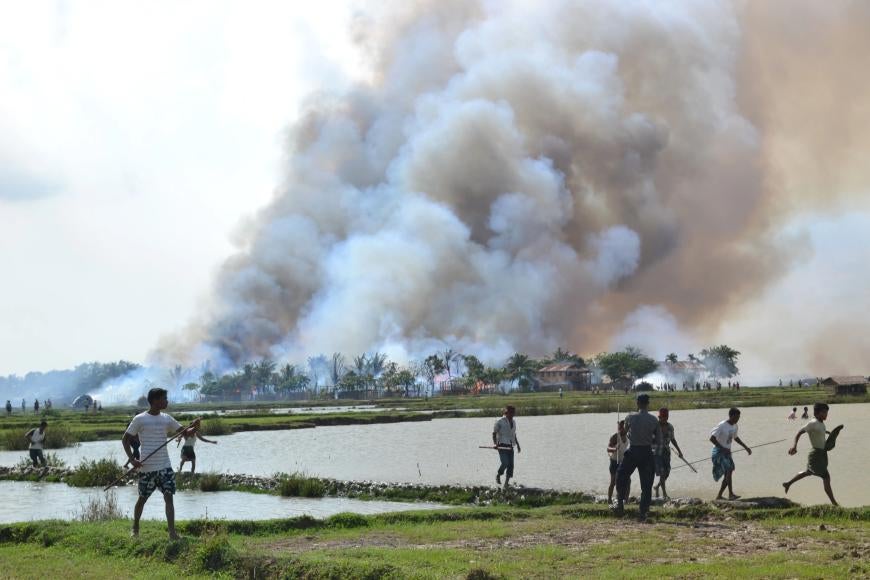In July, a month after the violence started, Thein Sein released a statement: “We will take care of our own ethnic nationalities, but Rohingyas who came to Burma illegally are not of our ethnic nationalities and we cannot accept them here.” The solution, he said, was to move them into United Nations-run camps or send them abroad.
Violence returned in October that year, planned and instigated by Rakhine ultranationalists, local officials, and extremist monks. Security forces stood by watching the attacks or joined in. “Police opened fire on the Rohingya who were fleeing,” Khadija Khatun said. “My husband died. One of my sons died. When we were fleeing from our village, the Buddhist neighbors, who we were living together with for so many years, were swearing at us and saying they wanted to shower with our blood.”
Hundreds of Rohingya were killed in June and October, their neighborhoods razed. More than 140,000 were displaced.

Police surround Rohingya who fled their houses amid violence in Sittwe, June 12, 2012. © 2012 STR/AFP/GettyImages
Kamal and other Rohingya describe June 2012 as the inflection point of their lives. For Myanmar officials, the violence offered a pretext for a longer-term solution to the “‘Bengali’ problem.” In the months and years that followed, they would roll out a policy to segregate and confine a population they had long sought to remove from daily life in the predominantly Buddhist country. “What they did in 2012 was overwhelm the Rohingya population,” a UN official who worked in Rakhine State at the time told us. “Corner them, fence them, confine the ‘enemy.’”
After a few months in a makeshift tent, Kamal and his family settled in Khaung Doke Khar camp, one of more than a dozen sites set up for displaced Rohingya northwest of Sittwe town. The scattered camps were sealed off with barbed wire fencing and military checkpoints.

A Rohingya man looks out from a barbed wire fence to restrict travel on the outskirts of Sittwe, November 25, 2012. © 2012 Paula Bronstein/Getty Images
Township and border guard officials began rounding up Rohingya whose homes weren’t affected by violence and sending them to the crowded displacement sites. A fisherman described being forced from his seaside village to the Sittwe camps. “The authorities told us to leave,” he said. If they stayed, officials warned them, “we would be killed and our villages would be burned.” Fleeing didn’t spare their homes. “Just after we left, we could see it was already on fire. We could see the smoke and flames.”
The authorities’ ethnic cleansing of Rakhine State took root. Today, in the town of Sittwe, where about 75,000 Rohingya lived before 2012—nearly half the town’s population—only 4,000 remain.
The 2012 violence and ensuing displacement inflamed anti-Muslim sentiment throughout Myanmar and ushered in an era of increased oppression, in both policy and practice, that laid the groundwork for more brutal and organized military atrocities in 2016 and 2017.
While several thousand Rakhine displaced in 2012 have long since resettled or returned home, 10 years later, more than 135,000 Rohingya and Kaman Muslims remain in the central Rakhine camps, detained arbitrarily and indefinitely. Hundreds of thousands more have fled the country to squalid and precarious camps in Bangladesh.
Myanmar officials have constructed a web of restrictions to deprive Rohingya of their liberty and erode their capacity to survive. This oppressive regime amounts to the crimes against humanity of apartheid, persecution, and imprisonment, carried out by successive civilian and military authorities.
In Myanmar, Bangladesh, and immigration detention sites across the region, Rohingya are trapped in stateless purgatory, awaiting the chance to return home. “We want justice,” Hamida Begum said. “We want to get back to our land. Even the animals like dogs, foxes, or other creatures in the forest have their own land, but we Rohingya don’t have any place—although we had our own place once.”
As the central Rakhine camps were set up in 2012 and 2013, authorities began imposing overlapping systems to restrict Rohingya’s movement—checkpoints and barbed-wire fencing, curfews, draconian permission procedures and police escorts, harassment and threats, and daily extortion and bribes.
In rural Sittwe today, Myanmar officials have interned about 110,000 Rohingya in a sprawling cluster of camps cordoned off with barbed wire fencing, most only kilometers from where they lived before 2012. The remaining 30,000 Rohingya and Kaman are confined to sites in Pauktaw, Myebon, Kyauktaw, and Kyaukpyu townships, further cut off by inaccessible waterways and terrain.
“Every day it is like we are under house arrest,” Myo Myint Oo said.
Constraints have only tightened over the past decade. “During my years inside the camp, I saw the situation becoming more and more strict,” said Mohammed Yunus, who fled to Bangladesh to escape the confinement. “It was like an open prison without end.”
Fatema Amir also fled the camps to Bangladesh in 2019. “No Rohingya could go outside without permission, there was no freedom of movement,” she said. “We had problems buying the things we needed. We had a food crisis and no jobs. When we were in our villages, we used to work alongside men. But after coming to the camps, us women were not able to go outside.”

A Rohingya boy watches soldiers patrol his camp in Sittwe, May 13, 2013. © 2013 Gemunu Amarasinghe/AP Photo
Access to and from the camps and movement within are heavily controlled by military and police checkpoints, while “unauthorized” attempts to leave end in arrest and ill-treatment by security forces. Authorities bar journalists and human rights monitors from entering. “These aren’t IDP [internally displaced person] camps — they’re detention centers,” a UN officer said.
Kamal’s shelter was near the camp’s police barracks. “Most nights we heard sounds of torture,” he said. “In the evening, no one was allowed to go outside of their shelter. If any Rohingya were found outside, they were tortured, and sometimes after torture they were sent to jail.” He heard Rohingya with breathing problems begging officers not to kick their chests. “Three years back, I witnessed a young Rohingya tortured to death just because he came outside,” he said.
“Life in the camps is so painful,” Mohammed Siddiq said. “There is no chance to move freely. We have nothing called freedom.”
As humanitarian agencies set up camp operations in 2012 and 2013, Myanmar national and state authorities repeatedly denied their requests for adequate land and resources to build sites in line with international standards. Instead, the government enforced strict technical guidelines that made overcrowding, flooding, and fires inevitable. “UNHCR [the UN refugee agency] would say, this plot can fit 800 houses, and they’d make us put in 1,200,” a UN official involved in the construction said.
Restrictions on aid groups have only grown over the past decade. The temporary shelters, originally designed to last just two years, have deteriorated with each passing monsoon season, prompting unending cycles of repair. The resulting living conditions are, by design, squalid.
“The camp is not a livable place for us,” Anwar Islam said.
“It is impossible to convey the degradation of life in these camps,” said Michael McGrath, then-Myanmar director for Save the Children, in 2019. “I have visited them many times, and they are among the worst places to live and to bring up children that I have seen during a long career in humanitarian work around the world. Families are crammed into a single room in a five-family ‘longhouse,’ bordered by endless lines of latrines in a sea of mud.”
Most of the sites sit on former paddy fields and low-lying coastal areas. During annual floods, the latrine pits overflow, contaminating hand pumps and wells and spreading disease.
In April 2022, with the monsoon season looming, the UN reported new restrictions imposed by the junta on infrastructure projects in the camps, leaving 28,000 Rohingya in unfit longhouses requiring urgent repair, many that “pose life-threatening risks to the inhabitants and other residents.”

Garbage is piled up at a camp in Sittwe, May 28, 2019. © 2019 Adam Dean/The New York Times/Redux
Humanitarian agencies report Rohingya children drowning in poorly secured latrine pits, wells, and stagnant ponds. After multiple fatal incidents in 2014, aid groups asked the government irrigation department for support to improve safety measures, without success. A 2019 humanitarian document notes—after another child died in a latrine—that almost all open water sources still lacked fencing.
Overcrowding among the camp longhouses and makeshift shelters is pervasive. “Things haven’t improved,” Aung Zaw Min said. “We are still in the long shelters, in the same situation. One shelter is only one room for all family members, and one long shelter has eight rooms for eight families from different places. In my family, we are 13 people. It’s difficult to fit in one room. We have no privacy.”
The uninhabitable conditions have led to a growing tally of preventable deaths. The UN-backed Fact-Finding Mission on Myanmar concluded that security forces had “deliberately inflicted conditions of life calculated to bring about the physical destruction of Rohingya”—or “measures of slow death”—a genocidal act.
Rohingya living in the camps face higher rates of malnutrition, waterborne illness, and child and maternal death than their Rakhine neighbors. Health indicators have only worsened over the past 10 years. Children continue to die from recurrent outbreaks of acute diarrhea, as recently as February 2022.
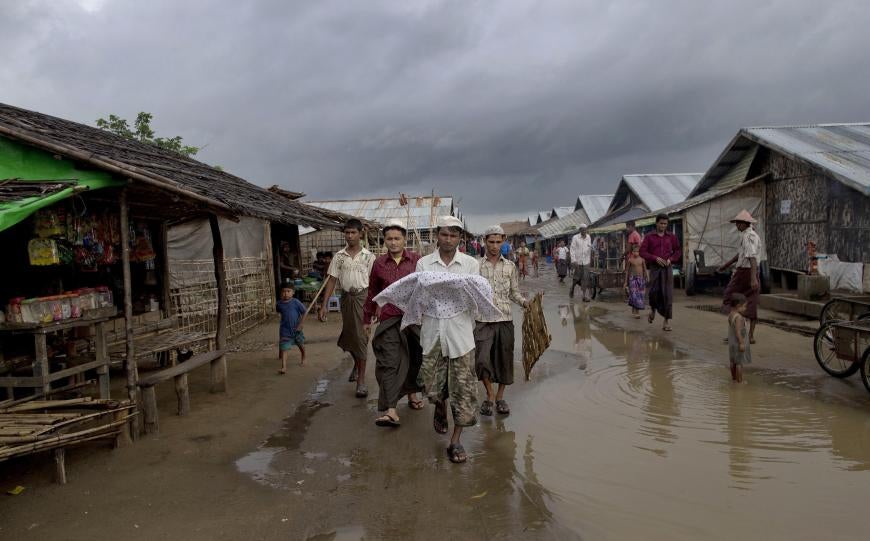
A Rohingya man carries the body of his niece who died hours after being born in Dar Paing camp in Sittwe, June 27, 2014. © 2014 Gemunu Amarasinghe/AP Photo
Medicine at a pharmacy that also serves as a makeshift clinic in the Thae Chaung camp in Sittwe, April 2014. © 2014 Minzayar/Reuters
Access to health facilities is mostly limited to basic in-camp clinics operated by nongovernmental organizations. Visiting Sittwe General Hospital, the only site for complex care that accepts Rohingya, requires excessive fees and an onerous referral process, even for life-threatening cases. Muslim patients are treated in a segregated ward under guard; blood donations are earmarked for ethnic Rakhine only.
“It’s difficult to prevent problems during delivery,” Myo Myint Oo said of the life-threatening risks to pregnant women and newborns. The women in his camp give birth with untrained attendants, he said. “Sometimes the mother and child die.”
Fears of Sittwe hospital are commonplace, fueled by rumors of callous doctors and unexplained deaths, fostering a reluctance to seek care until too late—a deadly cycle.
“Sometimes we didn’t take our children to the doctor because we believed that when our people go to the doctor, they don’t come back alive,” Hamida Begum said. “Sometimes our children died in our laps. We didn’t want them to die by Buddhist doctors. When our children died from lack of medical treatment, we had to bury them without any funeral.”
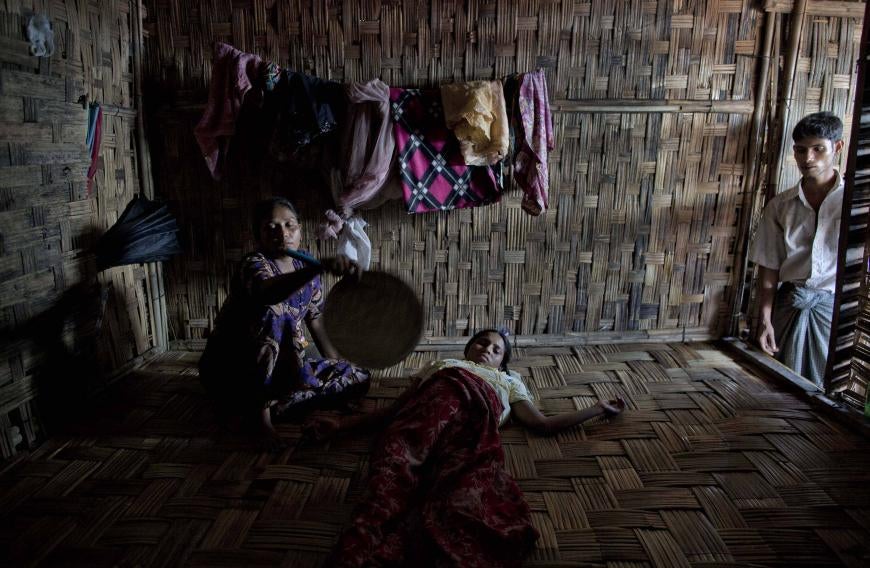
A 20-year-old Rohingya woman is fanned by a relative as she waits to give birth to her second child in Dar Paing camp, Sittwe, June 25, 2014. © 2014 Gemunu Amarasinghe/AP Photo
For most of the 72,000 children in the camps, access to education is limited to under-resourced temporary learning centers led by volunteer teachers.
Humanitarian groups say families are less and less motivated to seek out the minimal informal schooling that exists. They see no opportunities for their children, an aid worker said. “They think, ‘What’s the point of sending my kid to school? What can they do?’”
“My two sons used to go to the temporary learning centers since there were no school facilities,” Hamida Begum said. “There is no future there.”
More than 40,000 children have been born in the camps, knowing no life outside of confinement.

Rohingya children read and pray in Baw Du Pha camp in Sittwe, December 18, 2021. © 2021 Aung Naing Soe/Anadolu Agency via Getty Images
Children attend a class in a camp in Kyaukpyu, May 17, 2017. © 2017 Soe Zeya Tun/ Reuters
Depriving Rohingya of education serves to permanently marginalize the community, cutting off younger generations from imagined futures of self-reliance and dignity. Forcing children to grow up without learning Rakhine or Burmese languages, only speaking Rohingya, is hardening the barricade of segregation.
Kamal never returned to school after the violence broke out in 2012. Instead, he found occasional work with an aid group that paid 30,000 kyat (US$20) a month.
Most Rohingya were forced to abandon their pre-2012 trades. Former teachers and shopkeepers were left seeking ad hoc work as day laborers for an average of 3,000 kyat ($2) a day, largely dependent on foreign aid.
“Before 2012, I used to go to the main Sittwe port with my boat,” said Nur Kamal, who had worked as a fisherman before he was sent to the camps. “I lost my boat forever. Life became very hard. There was no freedom of movement, no work opportunities. Nothing was there after losing my boat.”
The lack of work has pushed large numbers of Rohingya to attempt high-risk escapes. Since 2012, about 170,000 Rohingya asylum seekers have embarked on smugglers’ boats in the Bay of Bengal and Andaman Sea, most hoping to reach Malaysia where a sizable Rohingya community holds the promise of work.
The voyages entail weeks or months on unseaworthy boats, often accompanied by abuse from unscrupulous traffickers. Sultan Ahmad has seen many flee from his camp. “Sometimes the people on the boats get arrested,” he said. “Sometimes they have to change direction because of the weather conditions; sometimes the boats sink and they die in the sea. But people still take the risk, because they say they can’t stay at home detained in the camp, and they don’t think they will ever be free.”
Indonesians rescue Rohingya refugees from a boat on the coast of North Aceh after officials said they planned to push them back out to sea, June 25, 2020. © 2020 Antara Foto/Rahmad via Reuters

Police bring Rohingya back to Sittwe after they were detained at sea while attempting to flee to Malaysia, November 30, 2018. © 2018 AFP via Getty Images
In April 2014, Myanmar census workers arrived at Kamal’s camp, flanked by police and military officers. For Rohingya, who were excluded from the nationwide census unless they identified as “Bengali,” the surveyors’ questions were brief. “The census team asked me, ‘What is your ethnicity?’” a man from Dar Paing camp said. “When I answered ‘Rohingya,’ they walked away.”
Rohingya’s right to nationality and identity has been steadily eroded over decades. In 1982, the military government adopted a new ethnic-based Citizenship Law that effectively denied the Rohingya citizenship, rendering them the largest stateless population in the world. Authorities collected and voided identity cards, replacing them with a succession of increasingly restrictive and regulated IDs.
The 1982 law leaves Rohingya exposed with no legal protection of their rights. By linking ethnicity to citizenship, and citizenship to freedom of movement and other basic rights, authorities created a multilayered system of oppression.

Census workers walk along with police officers to collect information at Dar Paing camp in Sittwe, April 2, 2014. © 2014 Khin Maung Win/AP Photo

A Rohingya man in Rakhine State displays his newly issued National Verification Card, indicating “Holding this identity card does not testify that the card holder is Myanmar citizen,” June 2018. © 2018 AFP via Getty Images
“They say we are foreign settlers,” a Rohingya man said. “My grandfather had a citizenship card. My mother. My father. My older brother. But they say I am not a citizen.” During the 2012 violence, officials and Rakhine villagers confiscated and burned many Rohingya’s documents. Some have kept past IDs, no longer recognized, a tangible link to their identity, the denial of which winds through everything else they’ve lost.
After the 2012 violence, the influence of Buddhist ultranationalist groups grew, tapping into the nationalist narrative that framed Muslims as an existential threat to the Buddhist state. Dehumanizing rhetoric spread nationwide.
Across Rakhine State, the infrastructure of apartheid eroded communication between the Rohingya and Rakhine, fostering deep mistrust and solidifying the “Rohingya other.”
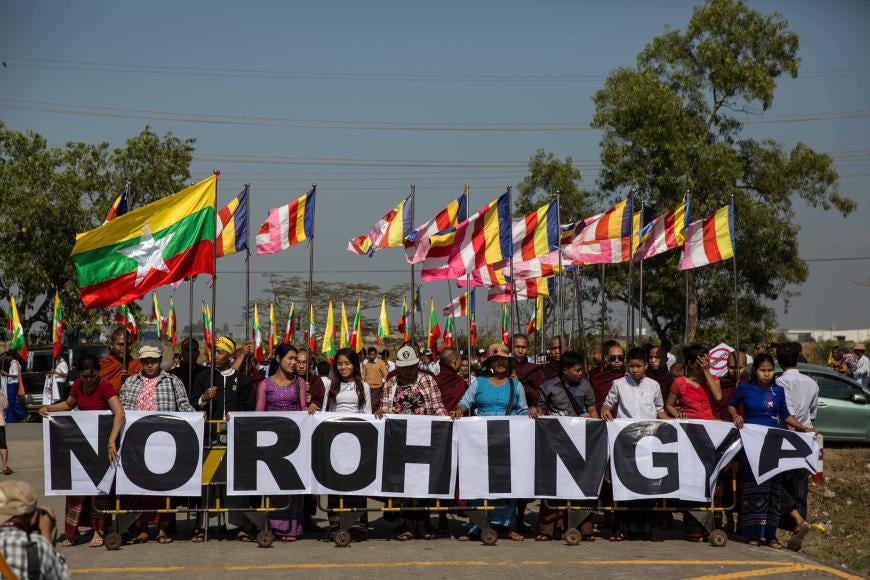
Supporters of the Buddhist ultranationalist group Ma Ba Tha protest the arrival of an aid delivery for Rohingya in Yangon, February 9, 2017. © 2017 Lauren DeCicca/Getty Images
Despite being disenfranchised in the 2015 national elections, many Rohingya held out hope that Aung San Suu Kyi and her party, the National League for Democracy, having won in a landslide, would end their internment and stem the hateful propaganda that pulsed in streets and, with growing fervor, online.
“After the 2015 elections, they have hope in the camps,” said Myat Noe Khaing, who had fled Rakhine State the year before. “They think things will change. After one year, they realize the Lady [Suu Kyi] will not do anything for us.”
In 2016, Suu Kyi, then leader of the country, instructed the UN and foreign governments not to use the term “Rohingya.”
Myat Noe Khaing wonders about the fate she has faced for simply being Rohingya. “Am I wrong? For being Rohingya, being from Rakhine? I ask myself, what did I do wrong? But there is nothing wrong with me.”
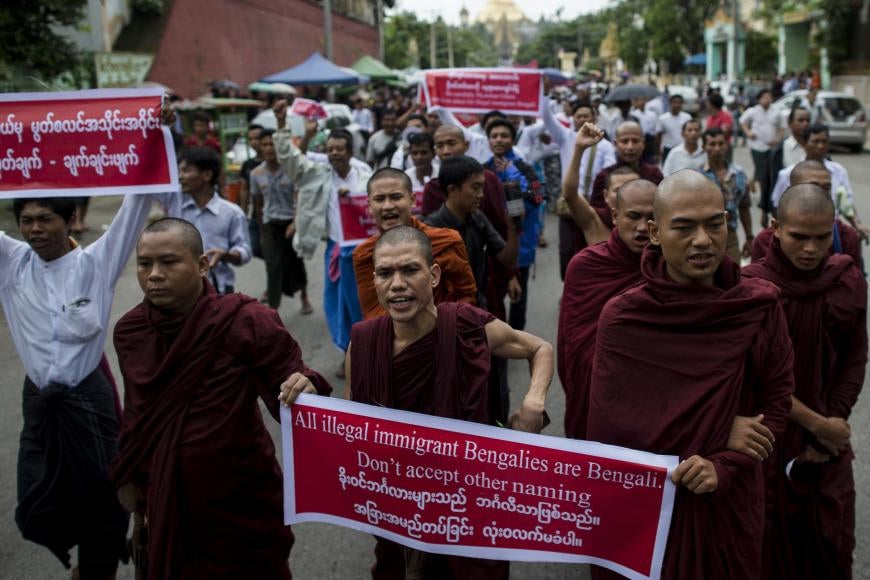
Buddhist monks take part in an anti-Muslim rally in Yangon, July 10, 2016. © 2016 Ye Aung Thu/AFP via Getty Images
In October 2016, an ethnic Rohingya armed group called Harakah al-Yaqin, which had formed in response to the 2012 violence, attacked three police outposts in northern Rakhine. Security forces responded with so-called clearance operations, killing and raping Rohingya and torching their towns.
In August 2017, after new attacks by the armed group, since renamed the Arakan Rohingya Salvation Army (ARSA), the military launched a sweeping, methodical campaign of massacres, rape, and arson. Thousands were killed. More than 730,000 Rohingya fled the genocidal acts for Bangladesh.
Central Rakhine grew increasingly militarized. In the camps, authorities set up new checkpoints and lengthened curfews. Police raids of shelters became more frequent, Rohingya said, “even to see if there is a knife in the kitchen.”
In one incident in October 2016, police rounded up a group of young Rohingya men from the Sittwe camps. “They told us not to create any problems for them and asked us to let them know if there were any ARSA people inside our IDP camps,” one man said. “They kept hitting us.”
Aid rations dwindled; markets were shut down. “After the 2017 violence, all movement stopped,” an aid worker in the camps said. As Rohingya in northern Rakhine were being beheaded and burned alive during military operations, in the internment camps, deaths from disease and poor health care climbed.
Today, about 600,000 Rohingya remain in Myanmar, detained under a system of apartheid and persecution that receives scarce international attention. Those living outside the camps face similarly oppressive restrictions, confined to villages scattered around Rakhine.
Across the border in Bangladesh, nearly one million Rohingya refugees live in overcrowded, flood-prone camps. The junta asserts it is undertaking plans for their repatriation, but refugees understand that no safety or freedom awaits them. “We know that thousands of Rohingya back in Myanmar are still in detention camps,” a refugee told us. “If those people are released and return to their villages, then we’ll know it’s safe to return.”
No one has been held accountable for the 2012 violence or the apartheid state that arose, nor the atrocities carried out since.
The early years of the camps coincided with Myanmar’s nascent transition to democratic civilian rule. From 2012 on, the United States, United Kingdom, and other governments appeared more concerned with embracing Aung San Suu Kyi and the country’s political and economic opening-up than with pressing the government on the internment camps in Rakhine State and the growing anti-Muslim discrimination and violence.
And so, despite all the international focus on Myanmar, with the UN and foreign governments watching, the warnings raised about the looming risks to the Rohingya went unheeded.
By the time violence broke out in October 2016, all international sanctions on the Myanmar government and military had been lifted. European governments welcomed Commander-in-Chief Sr. Gen. Min Aung Hlaing for goodwill visits. Even the 2017 atrocities only garnered a fragmented and halting response, with governments continuing to favor quiet diplomacy over strategic measures to hold the military accountable.
Humanitarian agencies working in the camps increasingly grappled with concerns about their own complicity in the state’s apartheid regime. An internal UN discussion note from 2018 concluded, “the very short-term humanitarian vision, despite being well-intentioned, resulted in de facto support of the government’s policy of segregation and detention sites.”
On February 1, 2021, Min Aung Hlaing and other generals responsible for the atrocities against the Rohingya detained Aung San Suu Kyi and other civilian leaders, thrusting the country back under full military rule. The junta has since carried out a bloody crackdown on the pro-democracy movement with the same callous disregard for life that drove its scorched-earth operations in Rakhine and other ethnic regions for decades. Security forces have killed more than 1,900 protesters and other civilians and arrested more than 14,000.
The roots of the coup and the bloodshed that has followed lie in the impunity that the military has long enjoyed.
In 2012, the ethnic cleansing and internment of the Rohingya offered governments a clear warning about the nature of the Myanmar military—about its dependence on violence to shore up its financial and political power and its utter disregard for civilian democracy. What if they had listened?
Since the coup, the military junta has imposed new movement constraints and blockages on aid to the camps, part of its widening restrictions on assistance that have created a nationwide humanitarian catastrophe. Aid agency memorandums of understanding with the civilian government have expired, while junta officials have delayed or denied visas for foreign aid workers. The requisite travel authorization process for humanitarian staff has grown even more erratic and constrained, impeding aid delivery to an estimated 440,000 people in Rakhine.
Rising tensions over control of the region between the Myanmar military and Arakan Army, the ethnic Rakhine armed group, have often left Rohingya caught in the middle. Some Rohingya describe eased restrictions on travel in areas under Arakan Army control, though the fraying ceasefire and contested administration offsets any benefit to their vulnerability.
The coup has also triggered widespread infrastructure collapse and a severe devaluation of the kyat, Myanmar’s currency. Humanitarian agency documents detail rising water scarcity and food shortages across Rakhine. Rohingya families reported facing starvation after the World Food Programme halted its monthly cash allowance and food distributions in June 2021. Disease and malnutrition have spread.
As pressures to leave Rakhine State mount, so too do punishments for attempting escape. Security forces arrested more than 1,400 Rohingya, hundreds of them children, for trying to flee during the 2021-2022 dry season. Junta courts have sentenced hundreds to the maximum five years in prison for attempting to “illegally migrate.”
Junta authorities have continued rolling out the National Verification Card process as part of its Pan Khin (Flowerbed Project) “citizenship scrutiny” exercise, coercing Rohingya to accept IDs that mark them as foreigners in their own country. “You take that card with that name,” Myat Noe Khaing said, “now you are not Rohingya, you are Bengali.”
Since the coup, people across Myanmar have sought to atone for past anti-Rohingya hostility and their support, explicit or passive, for the military’s persecution of Muslims. The opposition National Unity Government committed to ending Rohingya’s statelessness. Activists from the ethnic Bamar majority are carrying out solidarity campaigns, reimagining Myanmar as a state strengthened by its multi-ethnic, multi-religious makeup.

Myanmar protesters hold a message for Rohingya at an anti-coup demonstration in February 2021. © 2021 Twitter/@TheRohingyaPost
Rahima, from Say Tha Mar Gyi camp in Sittwe, told us that a Rakhine friend was able to visit her this year during Eid. But as long as the military is in power, she said, nothing will change.
Every Rohingya we interviewed said they want to return to their homes and land, as long as they can be safe and free. “We want to go back to our places of origin and work our jobs again and live again with our neighbors in peace, like before 2012,” Myo Myint Oo said.
No reparation has been made for lost lives, homes, and property. “Nobody has been able to return, nobody has been compensated,” said Hla Sein, a Muslim community leader. “We keep asking, even still we are asking for our land.”
Much of the Rohingya’s former land was taken over by the authorities or ethnic Rakhine. Officials have sold some stretches, like Sittwe’s waterfront, to developers. “During the conflict, most of our documents were destroyed,” Aung Zaw Min said. He owned two properties before 2012. “One [piece of] land is already occupied by Rakhine neighbors and another one is taken by the local authority for the new city project areas. So I can’t get back those two lands.”
In 2017, the National League for Democracy-led government announced it would begin closing the camps, a process the junta is now carrying forward. But the “closures” only entail replacing the temporary longhouses with permanent structures built near the existing sites.
“Nothing has changed,” said Myo Myint Oo, who lives in one of the “closed” camps. “We have had individual shelters since August 2018, but everything else has stayed the same as it was since June 2012. We don’t have freedom of movement, and still have major challenges for livelihood, income, and health.”
In Kyaukpyu, south of Sittwe, the junta is building permanent houses for Muslims from the Kyauk Ta Lone camp on flood-prone farmland next to the current site. Most lived in in Kyaukpyu town before 2012, only a few kilometers away, where they’ve long sought to return. “Their houses were not burned, but they are not allowed to go back,” Hla Sein said. “Now there are Rakhine living in their houses.”
After 10 years of detention, the sense of hopelessness in the camps is pervasive. Not one Rohingya said they believed their indefinite detention would end or that their children would one day live, learn, and move freely. “I think the system is permanent,” Myat Noe Khaing said of the camps’ future. “A long time ago they took our money. Nothing will change.”
Recommendations
Concerned governments should recognize the atrocities against the Rohingya and the post- coup military junta as intersecting crises that require a cohesive international response. The Rohingya’s freedom depends on the military being excised from the vast control it wields in every layer of Myanmar life.
The UN Security Council should end its inaction borne of anticipated vetoes by China and Russia and urgently pass a resolution that institutes a global arms embargo on Myanmar, refers the military’s grave crimes to the International Criminal Court, and imposes targeted sanctions on the junta and military-owned conglomerates. If China and Russia continue to oppose council action on Myanmar, other governments should bring concerted global pressure against them for upholding the junta’s widespread abuses.
The US, UK, EU, and other governments should work together to strengthen international sanctions to cut off the Myanmar military from the revenue funding its abusive operations, including its apartheid regime in Rakhine State. Governments should target the junta’s gas revenues, its largest source of foreign income, totaling about US$1 billion in annual profits. Broad coordination and enforcement are crucial for these to have an effective influence on the military.
All governments should explore every avenue for justice and accountability for the Myanmar security forces’ crimes against humanity, war crimes, and acts of genocide, including by formally supporting the case under the Genocide Convention brought by Gambia against Myanmar before the International Court of Justice and by actively pursuing investigations and prosecutions under the principle of universal jurisdiction.

